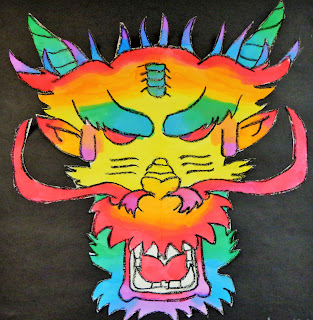Students in grades 4-6 created these vibrantly colored dragons to celebrate the Chinese New Year! We started by learning about Chinese New Year- the traditions, why each year is named after an animal and how people celebrate the holiday. Next, students looked at different examples of dragons and began sketching a dragon face. We chose the best sketch to draw large- folding the paper in half to only draw half of the face. The drawing was then traced with black crayon and rubbed off onto the other side to create a perfectly symmetrical dragon. For the painting, students could use any combination of colors they wanted as long as they kept the symmetry. Students loved the results especially because dragons are our school mascots!
Thursday, March 8, 2018
Wednesday, March 7, 2018
Watercolor Weavings
To create these artworks, students first began by creating an abstract textured watercolor painting. The students used an analogous color scheme to create a sense of color unity. These paintings were then torn into 1/2" strips and woven together on a large piece of paper. Weaving is an important method of art making around the world and most students enjoy the process.
Tuesday, March 6, 2018
Native American Buffalo Hides
2000 years ago, the Anasazi Indians inhabited the cliffs of
the Southwest. They were the ancestors of the Pueblo Indians who live there
today. There are 20 pueblo villages left; at one time there were 200! These
ancient villages are built from adobe bricks. These natural homes are warm in
winter and cool in summer; it rarely rains in the Southwest, so they won't
melt.
The Anasazi Indians left Petroglyph drawings on rocks and
cliffs. Some were chiseled into the rock with animal antlers, some were etched
with the acid juices from cactus plants. They are pictures of Indian symbols.
Symbols are pictures drawn very simply of things in nature, such as animals,
plants, stars, people, etc.
The Indians were very spiritual people. They respected the
earth, never wasted resources, and were ingenious at using the things in nature
around them.
Students created these buffalo hides over three classes. We
began by drawing a narrative using Native American symbols. After the drawing,
students covered the paper with a light brown watercolor and cut the paper to
look like a real buffalo hide.
The next class, students used fluorescent tempera paint to
paint in all of their symbols. For the last class, students outlined all their
symbols and also created a pattern around the edge of the hide.
Labels:
1-3 artwork,
narrative,
native american,
pattern
Subscribe to:
Comments (Atom)














